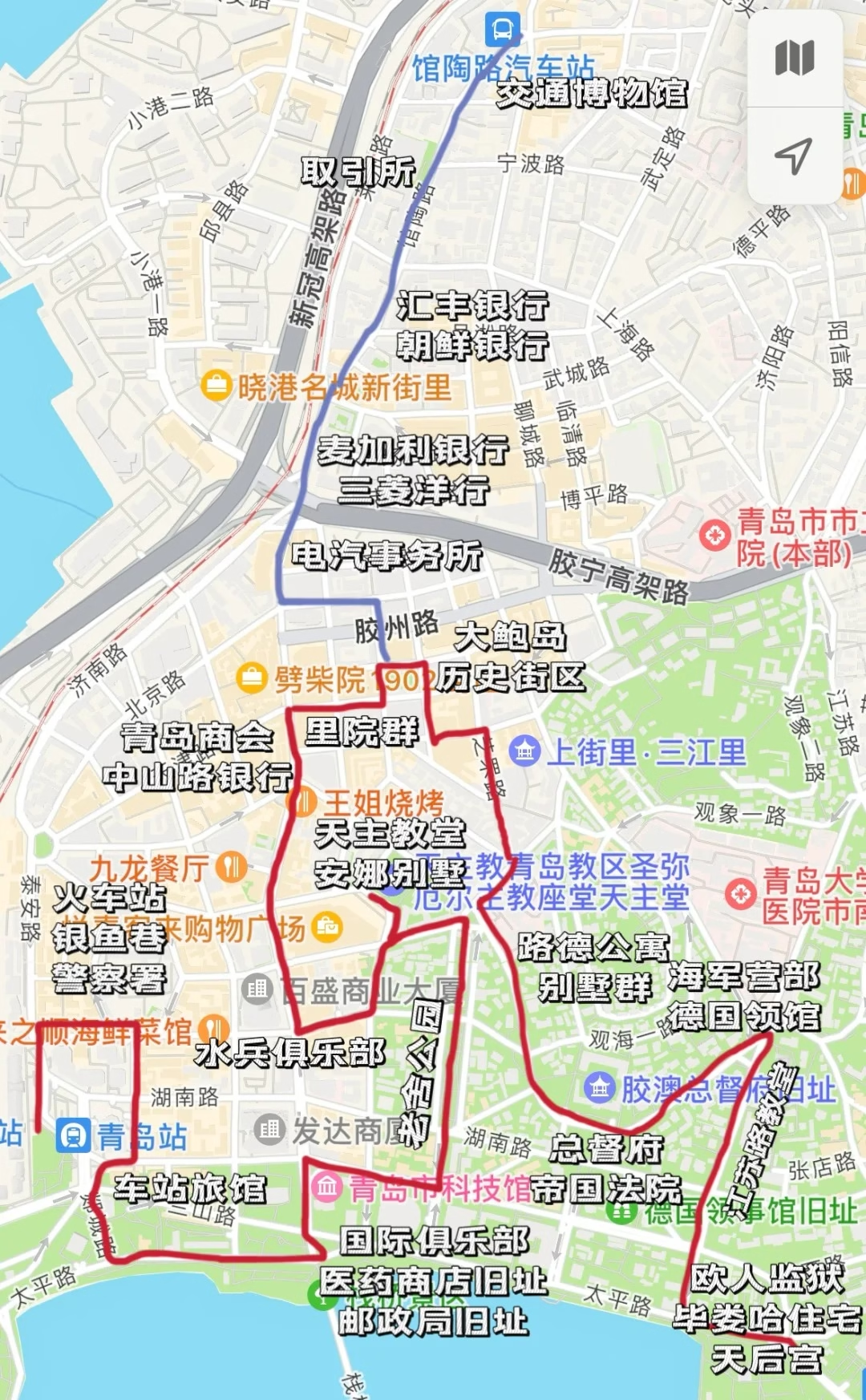Qingdao, with its rich history of German colonial architecture, is a city where the past and present merge in stunning ways. For architecture enthusiasts or anyone keen to explore the city’s unique blend of Eastern and Western influences, a walking tour of Qingdao’s historical buildings is a must. This guide takes you through a well-curated route, showcasing over 20 iconic German-style buildings and historical landmarks, from the old train station to the charming villas and churches scattered across the old town. In just one day, you can explore nearly 30 classic historical sites that reflect Qingdao’s colonial past.

Qingdao Train Station (青岛火车站) ➡️ Silver Fish Alley (银鱼巷) ➡️ Police Station (警察署) ➡️ Railway Hotel (车站旅馆) ➡️ Seaside Park (海边公园)
The first part of the tour begins around the train station area. Silver Fish Alley, with its recently renovated old streets and well-designed shops, offers a glimpse into the city’s past. Walking toward the seaside, you can stroll along the famous Zhanqiao Pier, enjoying views of the ocean and the surrounding cityscape.
Zhongshan Road: International Club (中山路一号/国际俱乐部) ➡️ Medicine Shop (医药商店) ➡️ Postal Museum (邮电博物馆) ➡️ Lao She Park (老舍公园) ➡️ St. Michael’s Catholic Church (圣弥厄尔天主教堂) ➡️ Anna Villa (安娜别墅) ➡️ Sailor’s Club (水兵俱乐部) ➡️ Zhongshan Road Historic District (中山路历史街区) ➡️ City Memory Museum (城市记忆馆)
Zhongshan Road is the core area for old buildings in Qingdao. From elegant villas and Western-style mansions to grand churches and banks, this road offers a diverse range of architectural gems. In recent years, Zhongshan Road has been transformed into a pedestrian-friendly zone, with cultural and tourism developments making it more accessible to visitors. Key spots along this route include the International Club (Zhongshan Road No. 1), St. Michael’s Catholic Church, and the City Memory Museum, a place to learn about Qingdao’s rich history.
Dabao Island District (大鲍岛街区) ➡️ Guangxingli (广兴里) ➡️ Manxin Hotel Rooftop (漫心酒店天台) ➡️ Courtyard Museum (里院博物馆)
Dabao Island is another recently revitalized area, showcasing a fusion of Eastern and Western architectural styles. The Courtyard Museum, with its emphasis on “community,” showcases how private and communal spaces create a harmonious interaction. During my visit, I stayed at the Manxin Hotel (漫心酒店), a trendy spot with a rooftop bar offering breathtaking views of the old city—definitely worth the experience!
Dexian Road Villas (德县路别墅群) ➡️ Governor’s Mansion (总督府) ➡️ Imperial Court (帝国法院) ➡️ Yishui Road Residences (沂水路宅院群) ➡️ Jiangsu Road Christian Church (江苏路基督教堂) ➡️ Tianhou Temple (天后宫) ➡️ Former Prison Site (监狱旧址)
This segment of the tour delves into Qingdao’s colonial core, focusing on official residences and key historical sites. The Governor’s Mansion, the Imperial Court, and the Christian church on Jiangsu Road are all part of the legacy of the German colonial period. Continuing towards Signal Hill, you’ll encounter even more popular landmarks such as the well-known Instagrammable walls, the Manga Street, and the Governor’s Building. If you have time, it’s worth spending an afternoon exploring these vibrant, historic streets.
Guantao Road Historic Building Cluster (馆陶路历史建筑群) ➡️ Trading Exchange (取引所) ➡️ Transportation Museum (交通博物馆)
On the second day, I visited the popular Guantao Road, although I must admit that its architectural quality and visitor experience don’t quite match those of the main city center. This area, mainly developed by Japanese trading houses, doesn’t have the same distinctive German-style charm. Although I didn’t visit the Trading Exchange due to time constraints, for those with limited energy, it’s better to focus on the main city attractions, where the architectural highlights are more prominent.

